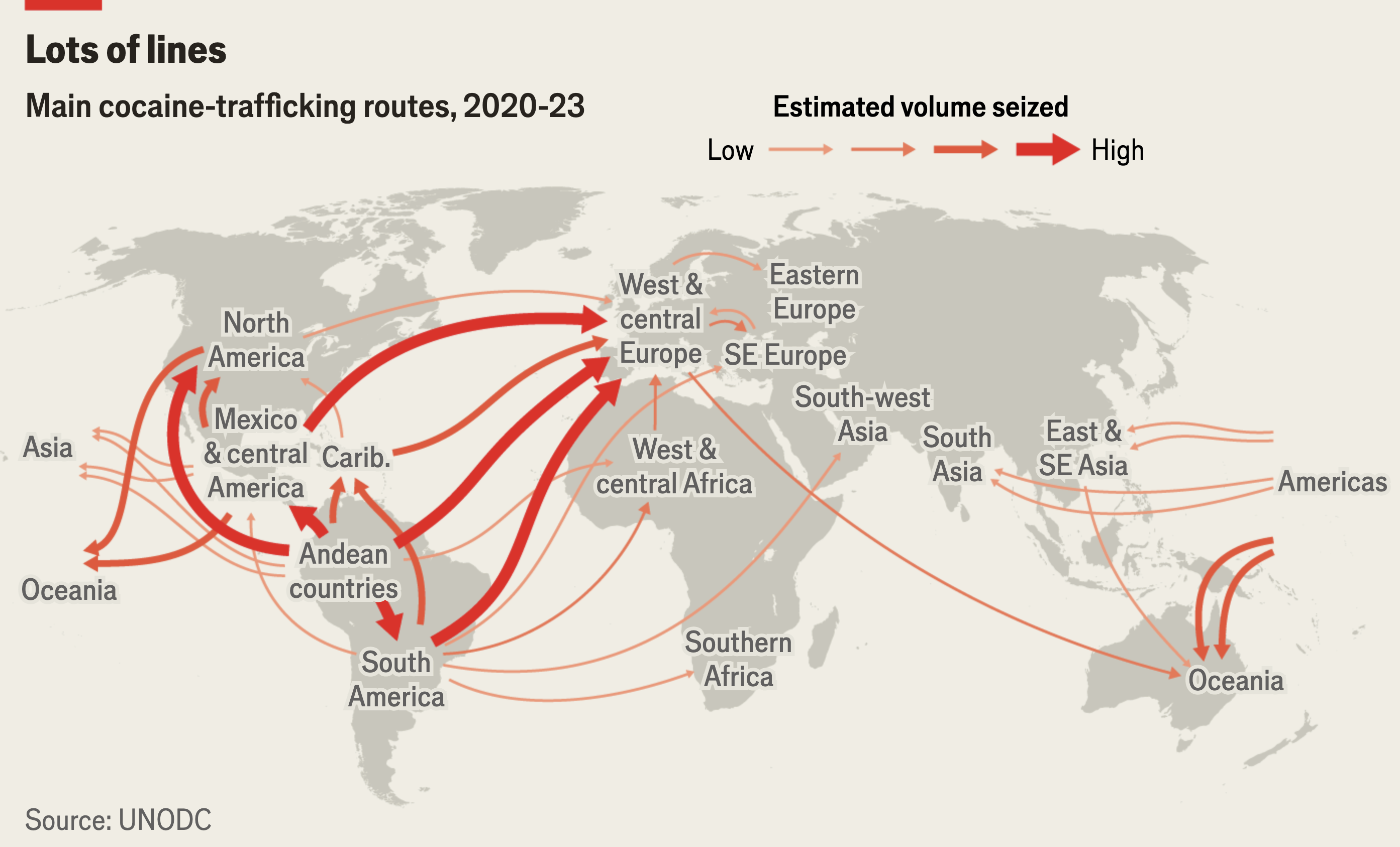Cocaine Trafficking Routes Map (2020-2023)


David Chen
Data Visualization Specialist
David Chen is an expert in transforming complex geographic datasets into compelling visual narratives. He combines his background in computer science ...
Geographic Analysis
What This Map Shows
The "Main cocaine-trafficking routes (2020-2023)" map vividly illustrates the complex web of pathways utilized by traffickers to distribute cocaine from its primary production areas to markets around the globe. This visualization highlights not only the primary routes but also the evolving dynamics of drug trafficking networks that have emerged over these recent years.
Cocaine, primarily sourced from coca plants predominantly grown in Colombia, Peru, and Bolivia, undergoes a transformation into a lucrative product that fuels a massive global market. The map reveals a shift in trafficking strategies, showcasing how traditional methods have been disrupted, leading to the rise of decentralized networks that are proving to be increasingly difficult to dismantle.
Deep Dive into Cocaine Trafficking
Cocaine trafficking is a multifaceted issue that intertwines geography, economics, and social factors. The journey of cocaine begins in the Andean region, where coca plants flourish due to the favorable climate and altitude. Interestingly, Colombia remains the largest producer, accounting for approximately 70% of the world’s cocaine supply. In 2022 alone, it is estimated that Colombia produced around 1,400 tons of cocaine, a statistic that underscores the scale of this illicit trade.
As the cocaine makes its way from the Andes to various global markets, it travels through a series of routes that are heavily influenced by geography, law enforcement efforts, and market demand. Traditionally, traffickers relied on vertically integrated gangs that controlled every aspect of the drug trade, from production to distribution. However, the last few years have seen the emergence of decentralized networks, where smaller, more agile groups operate independently, making it challenging for authorities to track and disrupt these operations.
What's fascinating is how these networks adapt to law enforcement strategies. For instance, after increased pressure in certain areas, traffickers have shifted their routes and methods, utilizing smaller boats, aircraft, and even drones to transport their product. This adaptability is what makes the cocaine trade so resilient.
Notably, the map also reflects the geographical shifts in trafficking routes. Historically, the Caribbean was a primary transit point for cocaine heading to the United States, but in recent years, traffickers have increasingly used Central America and Mexico, leading to a surge in violence and corruption in these regions.
Regional Analysis
When analyzing cocaine trafficking routes, it's essential to break down the regions involved. In South America, Colombia, Peru, and Bolivia are the epicenters of coca cultivation. Each country presents unique challenges and opportunities for traffickers. For instance, while Colombia has advanced infrastructure that facilitates quicker transportation, Peru’s remote areas provide cover from law enforcement.
As we move northward, Central America plays a pivotal role as a transit zone. Countries like Honduras and Guatemala have witnessed a dramatic rise in drug-related violence as traffickers fight for control over these key routes. The Sinaloa and Jalisco New Generation cartels in Mexico have also established strong connections with South American producers, creating a robust pipeline to the lucrative markets in the United States.
In Europe, cocaine use has been on the rise, leading to increased demand. Traffickers have adapted by establishing new routes across the Atlantic, utilizing shipping containers and even commercial flights to reach European cities. Interestingly, Spain has emerged as a significant entry point, largely due to its geographic proximity and historical ties with Latin America.
Significance and Impact
Understanding cocaine trafficking routes is crucial for several reasons. Firstly, it highlights the ongoing challenges faced by governments and law enforcement agencies in combatting drug-related crime. The shifting dynamics of trafficking networks pose a significant obstacle to traditional enforcement strategies.
Moreover, the social and economic implications of cocaine trafficking are profound. In regions where drug production and trafficking flourish, communities often face violence, corruption, and weakened governance. The impact on public health is also significant, with rising addiction rates and associated social issues.
Looking ahead, the future of cocaine trafficking will likely continue to evolve. As law enforcement becomes more adept at disrupting traditional routes, traffickers will undoubtedly innovate. Projections suggest that we may see an increase in synthetic drugs, which could further complicate the landscape of drug trafficking.
In conclusion, the map of cocaine trafficking routes from 2020 to 2023 provides critical insights into a complex global issue. By examining these routes, we can begin to understand the broader implications of drug trafficking on society and the ongoing challenges it presents for governments worldwide.
Visualization Details
- Published
- October 16, 2025
- Views
- 34
Comments
Loading comments...